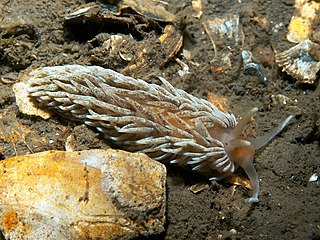Related Research Articles
Genus is a taxonomic rank used in the biological classification of living and fossil organisms as well as viruses. In the hierarchy of biological classification, genus comes above species and below family. In binomial nomenclature, the genus name forms the first part of the binomial species name for each species within the genus.

In taxonomy, binomial nomenclature, also called binominal nomenclature or binary nomenclature, is a formal system of naming species of living things by giving each a name composed of two parts, both of which use Latin grammatical forms, although they can be based on words from other languages. Such a name is called a binomial name, a binomen, binominal name or a scientific name; more informally it is also historically called a Latin name.

The International Code of Zoological Nomenclature (ICZN) is a widely accepted convention in zoology that rules the formal scientific naming of organisms treated as animals. It is also informally known as the ICZN Code, for its publisher, the International Commission on Zoological Nomenclature. The rules principally regulate:

The International Code of Nomenclature for algae, fungi, and plants (ICN) is the set of rules and recommendations dealing with the formal botanical names that are given to plants, fungi and a few other groups of organisms, all those "traditionally treated as algae, fungi, or plants". It was formerly called the International Code of Botanical Nomenclature (ICBN); the name was changed at the International Botanical Congress in Melbourne in July 2011 as part of the Melbourne Code which replaced the Vienna Code of 2005.

In zoological nomenclature, a type species is the species name with which the name of a genus or subgenus is considered to be permanently taxonomically associated, i.e., the species that contains the biological type specimen(s). A similar concept is used for suprageneric groups and called a type genus.

In biology, a type is a particular specimen of an organism to which the scientific name of that organism is formally attached. In other words, a type is an example that serves to anchor or centralize the defining features of that particular taxon. In older usage, a type was a taxon rather than a specimen.

A botanical name is a formal scientific name conforming to the International Code of Nomenclature for algae, fungi, and plants (ICN) and, if it concerns a plant cultigen, the additional cultivar or Group epithets must conform to the International Code of Nomenclature for Cultivated Plants (ICNCP). The code of nomenclature covers "all organisms traditionally treated as algae, fungi, or plants, whether fossil or non-fossil, including blue-green algae (Cyanobacteria), chytrids, oomycetes, slime moulds and photosynthetic protists with their taxonomically related non-photosynthetic groups ."
A conserved name or nomen conservandum is a scientific name that has specific nomenclatural protection. That is, the name is retained, even though it violates one or more rules which would otherwise prevent it from being legitimate. Nomen conservandum is a Latin term, meaning "a name to be conserved". The terms are often used interchangeably, such as by the International Code of Nomenclature for Algae, Fungi, and Plants (ICN), while the International Code of Zoological Nomenclature favours the term "conserved name".
The Botanical and Zoological Codes of nomenclature treat the concept of synonymy differently.

The Facelinidae are a taxonomic family of colorful sea slugs. These are specifically aeolid nudibranchs. They are marine gastropod molluscs.

Caloria is a genus of colorful sea slugs, aeolid nudibranchs. They are marine gastropod molluscs in the family Facelinidae.

Taringa is a genus of sea slugs, dorid nudibranchs, shell-less marine gastropod mollusks in the family Discodorididae.
Aporodoris millegrana is a species of sea slug, a dorid nudibranch, shell-less marine gastropod mollusk in the family Discodorididae.
Under the International Code of Zoological Nomenclature (Code), the name-bearing type is the biological type that determines the application of a name. Each animal taxon regulated by the Code at least potentially has a name-bearing type. The name-bearing type can be either a type genus, type species, or one or more type specimens. For example, the name Mabuya maculata has often been used for the Noronha skink, but because the name-bearing type of the former, a lizard preserved in the Muséum national d'histoire naturelle in Paris, does not represent the same species as the Noronha skink, the name maculata cannot be used for the latter.

Caloria indica is a species of sea slug, an aeolid nudibranch, a marine gastropod mollusc in the family Facelinidae.

Phidiana is a genus of sea slugs, aeolid nudibranchs, marine gastropod molluscs in the family Facelinidae.

Aeolidiella is a genus of sea slugs, aeolid nudibranchs, marine gastropod molluscs in the family Aeolidiidae.
Aporodoris is a genus of sea slugs, dorid nudibranch, shell-less marine gastropod molluscs in the family Discorididae.

Cerberilla is a genus of sea slugs, aeolid nudibranchs, shell-less marine gastropod mollusks in the family Aeolidiidae.

Tibicen is an historical genus name in the insect family Cicadidae that was originally published by P. A. Latreille in 1825 and formally made available in a translation by A. A. Berthold in 1827. The name was placed on the Official Index of Rejected and Invalid Generic Names in Zoology by the International Commission on Zoological Nomenclature in 2021. Certain European cicada species that were included by some authors in this genus at the time of its suppression are now listed under genus Lyristes Horváth, 1926. Many other formerly-Tibicen species are found in the genera Auritibicen Lee, 2015, Hadoa Moulds, 2015 Megatibicen Sanborn and Heath, 2016, and Neotibicen Hill and Moulds, 2015.
References
- ↑ Bergh, L. S. R. 1896. Eolidiens d'Amboine. In: Voyage de MM. M. Bedot et C. Pictet dans l'Archipel Malais. Revue Suisse de Zoologie et Annales de Musée d'Histoire Naturelle de Geneve 4:385-394, pl.16.
- ↑ Bouchet, P. (2015). Learchis Bergh, 1896. In: MolluscaBase (2015). Accessed through: World Register of Marine Species on 2015-12-19
- ↑ International Commission on Zoological Nomenclature. International Code of Zoological Nomenclature online Archived 2009-05-24 at the Wayback Machine Accessed 19-12-2015.